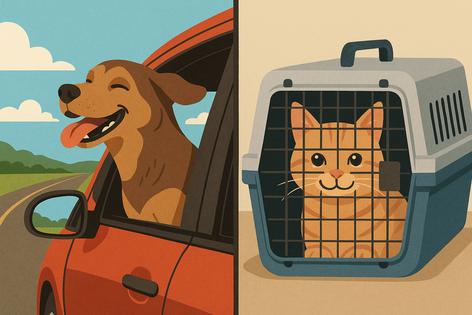Adventures in Pet Travel: Bringing Cats and Dogs Along for the Ride
Published in Cats & Dogs News
For many pet owners, leaving a cat or dog behind while traveling feels unthinkable. As airlines, hotels and even cruise companies expand their pet-friendly policies, the possibilities for four-legged companions to join in adventures have never been greater. Still, traveling with an animal is more than simply clipping on a leash or buying a carrier — it requires planning, patience and a willingness to see the world through paws as well as feet.
On the Road
Road trips remain the most practical way to bring pets along. Dogs, in particular, thrive on car journeys, where windows down and noses up provide endless entertainment. But preparation matters. Experts recommend acclimating animals to shorter drives before embarking on cross-country treks. Breaks every two to three hours give dogs a chance to stretch, relieve themselves and drink water. Cats can travel by car as well, though most prefer a secure carrier with familiar bedding.
Hotels and vacation rentals increasingly welcome pets. Major chains advertise pet-friendly rooms, often with modest fees, and smaller boutique properties sometimes cater directly to animal lovers. For road trippers, research ahead prevents last-minute surprises. Some state parks and beaches restrict animals, while others allow them freely on trails and shorelines.
Flying with Furry Friends
Air travel is more complicated. Small dogs and cats often can ride in the cabin if they fit in an airline-approved carrier that slides under the seat. Airlines limit the number of pets per flight, so reservations must be made early. Larger animals may travel in cargo holds, though this option raises concerns about safety and stress. Breed restrictions also apply, particularly for brachycephalic dogs such as pugs and bulldogs.
Veterinarians urge owners to weigh the risks before flying pets. Sedation is discouraged, as it interferes with breathing and body temperature regulation. Instead, familiar blankets, calming pheromone sprays and gradual acclimation to carriers can ease anxiety. For international flights, vaccination records and microchips are often required, along with health certificates that must be issued within days of departure.
By Rail and Sea
Trains and ferries offer alternatives that are growing in popularity. In the United States, Amtrak allows small dogs and cats on many routes for a modest fee, provided they remain in carriers. European trains are generally more accommodating, with pets allowed in both cabins and special compartments depending on size. Ferries crossing channels or connecting islands often set aside pet-friendly areas, some even offering kennels on board.
Cruises present a different challenge, but niche companies and transatlantic liners occasionally make exceptions. Cunard’s Queen Mary 2, for example, famously provides kennels for dogs and cats crossing between New York and Southampton, complete with a full-time kennel master.
Keeping Pets Comfortable
Wherever the journey leads, comfort and safety remain paramount. Portable bowls, collapsible water bottles and familiar toys ease transitions from home to hotel. For cats, small litter trays designed for travel can prevent accidents, while dogs benefit from harnesses that clip into seat belts or carriers anchored to car seats.
Routine also matters. Feeding pets at regular times and offering exercise breaks help minimize stress. Owners should watch for signs of anxiety: panting, drooling, hiding or excessive vocalization. For particularly nervous animals, consulting a veterinarian about calming supplements or behavior strategies can make the difference between a stressful trip and a smooth one.
The Payoff
For those willing to do the work, the rewards are considerable. A hike with a dog through national park trails or a cat curled up in a mountain cabin deepens the sense of companionship. Owners often report that seeing the world with pets adds a layer of joy that outweighs the planning challenges.
Traveling with pets is no longer a rarity but part of a growing movement to make adventures inclusive of all family members, four-legged or otherwise. With thoughtful preparation, a car ride, flight or rail journey becomes less about logistics and more about memories made together.
========
This article was created, in part, utilizing AI tools.









Comments